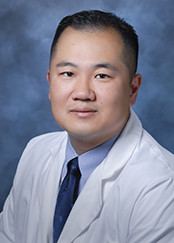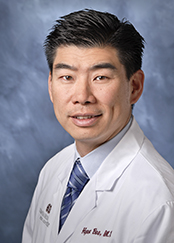Cedars-Sinai Blog
New Spine Technique Returns Patient to his Feet
Aug 29, 2023 Cassie Tomlin

In spring 2021, a year into the COVID-19 pandemic, Joe Duron was as busy outdoors as he’d ever been. He worked out every day, played racquetball and pickle ball, and on weekends he hiked, snowboarded and fished with friends.
When a mountain bike crash left him with a compressed nerve in his lower spine, all of that dissipated. For two years, consistent pain and numbness from his lower back to his right toes robbed him of his active, social lifestyle.
But after a cutting-edge, minimally invasive spine surgery performed for the first time at the Cedars-Sinai Spine Center by Sang Kim, MD, Duron is regaining his abilities and his happiness.
“It’s been a really big turnaround in my life and my wellbeing,” he said. “It’s night and day compared to what I was dealing with.”

Sang D. Kim, MD
A Second Opinion
After the injury, Duron couldn’t sit long, and he couldn’t sleep—he stayed up until he was sure to fall into bed too exhausted to be distracted by pain and numbness. The compressed nerve caused tightness in his calf so extreme he had to stand on one leg to wash dishes.
The injury also hurt his work as a life coach.
“I was irritable, and I wasn’t able to be my true self to help my clients the way they needed,” he said. “I wasn’t able to do much at all.”
One surgeon suggested artificial disc replacement surgery, an extensive procedure during which parts of the spine are removed and replaced with a metal implant.
He sought a second opinion with Kim, who assured him he could recover with a much less invasive procedure while keeping his spine intact.
First, Kim prescribed nonsurgical methods including steroid injections and physical therapy. When the pain and numbness didn’t improve, doctor and patient agreed to approach the compressed nerve with a pioneering surgical technique new to Cedars-Sinai.
"New technologies come out all the time in spine, but this has been exciting to us because it spares patients a more invasive surgery. It’s a stealth way of eliminating problems without causing trauma to the spine."
A Pioneering Technique
Nerves are protected by the spine, so to reach them to relieve pressure, surgeons traditionally needed to perform open-back operations to remove and re-fuse the bones. The operation can destabilize the spine and puts patients at risk for inflammation and bleeding.
But traditional open surgery often does not adequately relieve nerve compression. Using a new, dual portal technique, surgeons operate an arthroscope through an incision smaller than 4 millimeters, and decompress the nerve with instruments through another 8-millimeter incision. Traditional endoscopic surgeries use a single incision for the camera and the instruments. With the dual portals, the surgeon has a greater field of vision, allowing better camera angles and more freedom with the instruments compared to open surgeries.
“New technologies come out all the time in spine, but this has been exciting to us because it spares patients a more invasive surgery,” Kim said. “This technique will truly alter my surgical treatment recommendations for some of my patients. Patients that traditionally would have been recommended fusions will be undergoing minimally invasive nerve decompressions.”
Kim hopes to eventually extend the less invasive surgical option to patients with scoliosis, who often suffer nerve compression without back pain.
Kim performed the surgery, and Duron went home the same day. Within two weeks, the numbness and discomfort had disappeared completely.
Back to Before
Duron is grateful to again hike in Griffith Park, Kenneth Hahn State Recreation Area and the Pacific Palisades. On a recent trek in Mt. Wilson, he marveled over his ability to dash into ravines and scramble over downed tree trunks.
With exercise and physical therapy, Duron predicts that within months, he’ll fully regain the strength and endurance he had before the bike accident.
“We all want to stay active as long as we can, and the way our spines physically age is not going to change,” said Hyun Bae, MD, the other Cedars-Sinai surgeon who performs the two-portal technique. “As we improve our lifespan and quality of life, this true minimally invasive procedure reduces downtime and gets people back to their fullest activity as soon as possible.”



